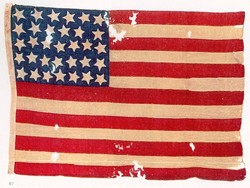

Obverse - edit
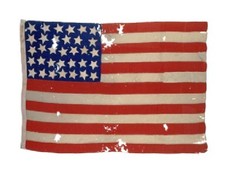
Obverse - edit 2
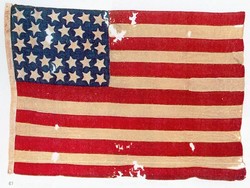
Obverse - edit 3
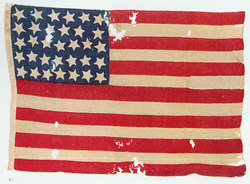
Obverse
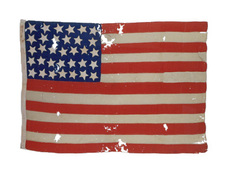
Book Photo
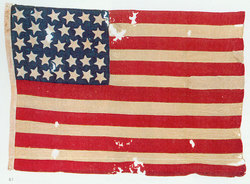
Obvese - 2
U.S. 33 Star Flag - Oregon.
Sub-collection: Mastai - Early American FlagsU.S. 33 Star Flag - Oregon.
Although both the Navy and the Army regulations in force at the end of the 1850s specified that the canton in the Stars and Stripes was to extend down through the seventh stripe (counting from the top of the flag), nothing in any of the flag enactments of the era specifically indicated the relative proportions of the union to the overall flag. Not surprisingly, therefore, a number of flag makers interpreted the lack of specificity as a license to follow their own whims regarding the size and proportions of the canton.
In this flag the canton extends through the top six stripes only, rather than the traditional seven. A claim made in 1880 indicated that ships ensigns manufactured in the Gosport Navy Yard at Portsmouth, Virginia, during the second quarter of the 19th century were all made with cantons that were only six stripes deep. However, the earliest specifications concerning U.S. Navy flags and ensigns clearly state that the canton was to extend through seven stripes (i.e. to be 7/13ths the width of the flag) and later Navy Regulations further specified that the length of the canton was to be 4/10ths the overall length of the flag. To explain the six-stripe canton depth, a hypothesis evolved that any flag made with the canton resting on a red stripe indicated its manufacture during a period of war. Neither documentary nor inductive evidence supports this myth.
Exhibition History:
First Presidio Exhibit
(ZFC0610)
33-Star United States Flag
Second Presidio Exhibit, 2003 GALLERY III
(ZFC0610)
33-Star United States Flag
Provenance:
• Acquired by Mr. & Mrs. Boleslaw & Marie-Louise D'Otrange Mastai, New York City, and Amagansett, NY, The Mastai Collection, until 2002.
• Sold via Sotheby's Auction in New York City to the Zaricor Flag Collection, 2002.
ZFC Important Flag
Item is Framed
Sources:
33 Star Flag - (1859-1861) (U.S.), Flags of the World, 27 May 2012, from: http://www.crwflags.com/fotw/flags/us-1859.html
Pierce, J. Richard, The Stars and Stripes: Fabric of the American Spirit, J. Richard Pierce, LLC., Whitehouse Station, 2005.
Image Credits:
Zaricor Flag Collection
Hoist & Fly | |
|---|---|
| Width of Hoist | 34.75 |
| Length of Fly | 49.25 |
Stars | |
|---|---|
| Comments on Star Measurements | 6-6-7-7-7 horizontal rows |
Frame | |
|---|---|
| Is it framed? | yes |
| Frame Height | 41.5 |
| Frame Length | 56.5 |
Stars | |
|---|---|
| Number of Stars | 33 |
| How are the stars embeded? | Sewn |
| Are there stars on obverse? | yes |
| Are there stars on reverse? | yes |
Stripes | |
|---|---|
| Number of Stripes | 13 |
| Color of Top Stripe | Red |
| Color of Bottom Stripe | Red |
| Has a Blood Stripe? | yes |
Nationality | |
|---|---|
| Nation Represented | United States |
Fabric | |
|---|---|
| Fabric | Wool |
| Comments on Fabric | Bunting |
Attachment | |
|---|---|
| Method of Attachment | Grommets |
Applica | |
|---|---|
| Applique Sides | Single Faced = Mirror Image Reverse |
Condition | |
|---|---|
| Condition | Good |
| Damage | flag is used, worn and contains moth. |
| Displayable | yes |
Date | |
|---|---|
| Date | 1859-1861 |
Exhibits | |
|---|---|
| Exhibition Copy | First Predidio Exhibit (ZFC0610) 33-STAR UNITED STATES FLAG Date: 1859-1861 Media: Wool bunting and cotton stars; all hand-sewn Comment: Although both the Navy and the Army regulations in force at the end of the 1850s specified that the canton in the Stars and Stripes was to extend down through the seventh stripe (counting from the top of the flag), nothing in any of the flag enactments of the era specifically indicated the relative proportions of the union to the overall flag. Not surprisingly, therefore, a number of flag makers interpreted the lack of specificity as a license to follow their own whims regarding the size and proportions of the canton. In this flag the canton extends through the top six stripes only, rather than the traditional seven. A claim made in 1880 indicated that ships ensigns manufactured in the Gosport Navy Yard at Portsmouth, Virginia, during the second quarter of the 19th century were all made with cantons that were only six stripes deep. However, the earliest specifications concerning U.S. Navy flags and ensigns clearly state that the canton was to extend through seven stripes (i.e. to be 7/13ths the width of the flag) and later Navy Regulations further specified that the length of the canton was to be 4/10ths the overall length of the flag. To explain the six-stripe canton depth, a hypothesis evolved that any flag made with the canton resting on a red stripe indicated its manufacture during a period of war. Neither documentary nor inductive evidence supports this myth. Provenance: Acquired by the Zaricor Flag Collection (ZFC0610) in 2002 from the Mastai Flag Collection of New York City through auction at Sothebys. Second Presidio Exhibit, 2003 GALLERY III (ZFC0610) 33-Star United States Flag Date: 18591861 33 Stars: July 4, 1859-July 3, 1861 (Oregon statehood February 14, 1859) Media: Wool bunting and cotton stars; all hand-sewn Comment: Although both the Navy and the Army regulations in force at the end of the 1850s specified that the canton in the Stars and Stripes was to extend down through the seventh stripe (counting from the top of the flag), nothing in any of the flag enactments of the era specifically indicated the relative proportions of the union to the overall flag. Not surprisingly, therefore, a number of flag makers interpreted the lack of specificity as a license to follow their own whims regarding the size and proportions of the canton. In this flag the canton extends through the top six stripes only, rather than the traditional seven. A claim made in 1880 indicated that ships ensigns manufactured in the Gosport Navy Yard at Portsmouth, Virginia, during the second quarter of the 19th century were all made with cantons that were only six stripes deep. However, the earliest specifications concerning U.S. Navy flags and ensigns clearly state that the canton was to extend through seven stripes (i.e. to be 7/13ths the width of the flag) and later Navy regulations further specified that the length of the canton was to be 4/10ths the overall length of the flag. To explain the six-stripe canton depth, a hypothesis evolved that any flag made with the canton resting on a red stripe indicated its manufacture during a period of war. Provenance: Acquired by the Zaricor Flag Collection (ZFC0610) in 2002 from the Mastai Flag Collection through auction at Sothebys of New York City. |
Publications | |
|---|---|
| Publication Images | |
| Flag Books | |








